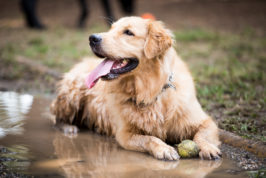When should you consider dog hydrotherapy?
When exactly is the right time to consider hydrotherapy for your dog? Dr Rebecca Macmillan explains…
Hydrotherapy is a type of in-water physiotherapy, and it’s a great way of providing low-impact exercise in order to build and tone muscle. The water helps support your dog and gives gentle resistance for them to work against while they exercise. It also stops your dog from jarring their painful joints against the hard ground, while still being able to improve their muscle tone.
Which conditions can hydrotherapy be used for?
Hydrotherapy can be used for a variety of conditions, but most commonly for rehabilitation after orthopaedic surgery or for dogs with Arthritis – either degenerative (age-related) or secondary to congenital issues, such as Elbow Dysplasia or Hip Dysplasia.
A fuller list of conditions includes…
- Joint diseases – Osteoarthritis, Hip Dysplasia, Elbow Dysplasia, Spondylosis and Patella Luxation
- Post-surgery rehabilitation – Hip replacement, cranial cruciate ligament surgery, Arthroscopy and Patella Luxation
- Neurological conditions – spinal injuries, Degenerative Myelopathy, Intervertebral Disc Disease, Neuromuscular Disease and peripheral nerve issues.
- Muscular injuries – strains and sprains, as well as ligament injuries
- Obesity – ‘fitness swims’ can be a useful exercise program for obesity
The benefits of hydrotherapy for these ailments include an improvement in muscle tone and mass, which will help support diseased joints, as well as a reduction in swelling and stiffness. Many dogs enjoy hydrotherapy, and the warm water can help soothe aches and pains. Dogs that under-go rehabilitation post-surgery tend to make a quicker return to normal function.
There may be other cases where hydrotherapy could be helpful – you should discuss your dog’s individual condition with your vet.
How can I tell if my dog needs hydrotherapy?

Signs that your dog may benefit from hydrotherapy include lameness when walking, difficulty getting up and down, generalised stiffness and evidence of pain or discomfort. The latter may be seen when you touch a specific area of their body. Or, for some dogs, they may seem more irritable than normal. Some dogs may have changes in their weight or energy levels when struggling with joint issues.
What else could help dogs with muscular and orthopaedic issues, alongside hydrotherapy?
Your vet will be able to advise you about the treatment options suitable for your dog, but in many cases, a combination of approaches is best…
Joint supplements
These are a natural way of helping treat your dog’s joint disease. Many supplements contain ingredients such as Chondroitin and Glucosamine, which help maintain healthy cartilage (the buffer that sits in joints). Other ingredients like Omega 3 and Hyaluronic Acid can help act as anti-inflammatories and lubricate joints. This can help make exercise and certain movements more comfortable when doing hydrotherapy.
Non-steroidal anti-inflammatories (NSAIDS) and other pain relief
NSAIDs can help dogs to feel more comfortable when doing their hydrotherapy, and are a commonly used medication that acts as both a painkiller and an anti-inflammatory. Many dogs take this type of medicine regularly, and it’s useful for both short and long-term issues. Side effects such as stomach upsets can occur, but this is relatively uncommon. For some dogs, additional medications may be needed for pain relief, such as Tramadol or Gabapentin.
Physiotherapy
Many different physiotherapy techniques may be utilised to improve your dog’s condition. This includes direct hands-on contact from a physiotherapist, and techniques such as acupressure and joint mobilisation. Other more modern treatments might include laser therapy.
Acupuncture
A less common and readily available treatment, where small needles are placed in your dog at specific acupuncture points which help change energy flow. It can stimulate the nervous system and improve blood circulation to help with healing.
Weight management
One of the cornerstones of managing joint disease and other orthopaedic conditions is weight management. Keeping your dog lean and fit will mean less pressure on their joints, which in turn means less wear and tear. The exercise that hydrotherapy provides can help dogs to lose weight, in conjunction with a weight reduction diet, which your vet or vet nurse will be able to advise you on. As with humans, a real improvement in many joint problems can be made through weight loss.
Discussing hydrotherapy with your vet
Your vet will be able to help guide you on how suitable hydrotherapy is for your pet, and may even be able to recommend a local hydrotherapy centre, where you can discuss things further
Your vet will also be able to advise you on other treatments that might help your dog, including painkillers or changes in diet. For many conditions, a combination of treatments may be required to best support your pet. Whether you give hydrotherapy a go or not may also be dictated by your dog’s personality, as aggressive, fearful dogs may not be safe to handle in the water.
Conclusion
Hydrotherapy is suitable for a whole array of muscular and orthopaedic conditions, including Arthritis and post-surgery rehabilitation. Your vet will also be able to advise you on other available treatments, such as painkillers and diet adjustments. As well as the health benefits, many dogs enjoy their time at hydrotherapy – just one more incentive to give it a go!




